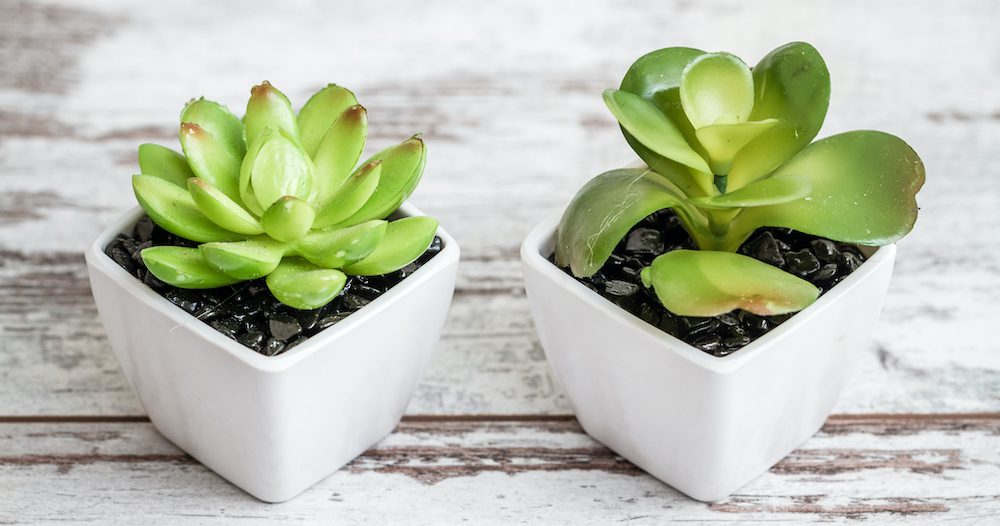
OZ_Media / Getty Images
Plants provide a beautiful backdrop in a home, but since they’re living things that need watering and care, many wonder whether they can get away with fake plants. Can they pass as the real thing?
It’s a timely question, given faux foliage has improved by leaps and bounds in recent years. They’re even part of Chip and Joanna Gaines‘ Target line! Nonetheless, you may still feel torn between the low-maintenance ease of faux plants or the natural beauty of live ones.
To help you sort this out, we spoke to home designers to get their expert opinion on the merits of each green decor option. Here’s how to decide between real and fake plants.
Real vs. fake plants in the house: Which is better?
Here are a few questions that Decorist designer Lauren Martin recommends considering when it comes to making the real vs. faux call.
- How often are you home? “If you travel very frequently with no one else at home, care for even the lowest-maintenance real plants can be challenging,” Martin says.
- Do you have curious pets? “Sometimes dogs/cats find familiarity and comfort in nibbling on real plants or digging in potted soil,” she explains. And they can create a big mess if they get too playful.
- What level of maintenance are you looking for? “Some people prefer little to none, while some people enjoy caring for and watching a plant grow over time,” Martin says. Yet despite what people may say, fake plants aren’t the low-to-no maintenance option we tend to assume they are. “While I understand the appeal of zero maintenance, practically speaking, it’s actually not the case,” Martin says. “Fake plants require regular cleaning to avoid dust buildup. This can be more time-consuming and costly than a quick once-a-week water.”
- Are you staging your home for sale? If so, then faux may be the way to go. “Home stagers often use faux plants for installations because they will be in a home from a few weeks to a few months depending on how long it takes to sell a property,” Martin explains. However, she adds, “in the past few years, we’ve seen multiple companies rent real potted plants and provide a weekly maintenance and watering service.”
Can you tell the difference between faux and real plants?
“I can almost always tell the difference,” says Martin, who also acknowledges that faux plants have improved a great deal in recent years.
“Faux plants have gotten much better due to many factors, including the quality and technology of silk or other materials used, a more dynamic combination of matte and glossy finishes,” Martin says. “And overall there’s a more diverse plant selection—architectural, sculptural species over the more traditional floral arrangements.”
What are the best fake plants to buy today?
Martin recommends faux plants from Terrain. Here are a few of its offerings:
Faux amaryllis
Terrain
Looking for something simple and chic? This faux amaryllis ($58, Terrain), which comes in a distressed metal pot, is a low-key way to bring a little extra pop of color to any room in your home.
Faux lemon cypress topiary
Terrain
If you want something a little bigger and bolder, consider this faux lemon cypress topiary ($54, Terrain), which comes in a rustic, distressed pot and brings a beautiful bit of green to your home decor.
Faux snake plant
Terrain
Finally, for a bold, tropical pop, consider this faux snake plant ($68, Terrain), which comes in a sleek metal pot.
Martin also recommends Nearly Natural‘s faux plant options. Here are some examples:
Silk orchid phalaenopsis
Nearly Natural
If you’re looking for gorgeous silk flowers in vibrant shades, Nearly Natural’s silk orchid phalaenopsis ($77.99, which comes in a set of three) definitely fits the bill.
Silk agave plant
Nearly Natural
Nearly Natural also offers silk succulents, including this large, artificial agave plant ($64.99), if you’re looking to add a very Instagrammable vibe to your space.
Silk cactus plant
Nearly Natural
And, finally, if you were worried that the prickliest picks from nature couldn’t possibly be reproduced from something as soft as silk, think again. Nearly Natural’s silk ,17-inch artificial cactus ($54.99) looks sharp in every way.
The DIY option: How to make fake plants
Believe it or not, making fake plants at home has become a hot trend, thanks to Corrie Beth Hogg, author of “Handmade Houseplants.”
“She’s an artist who creates fun, playful, very real-looking faux plant arrangements out of paper,” Martin explains. “If you’re unsure of committing to a live plant, yet feeling conflicted over faux, we love this option.”
Amazon.com
Here are a few of Hogg’s creations on Instagram that might get you excited to try creating some fake foliage yourself:
https://www.instagram.com/p/B4mtUxfD2tN/
The post Real vs. Fake Plants: Which Is Better for Your Home? appeared first on Real Estate News & Insights | realtor.com®.
I am thinking of installing fake green wall in my office because the lack of greens and this comparison came out just in time. There are many sellers of artificial plants and I really have no idea which one to choose from. I am thinking of Designer Plants USA because of their resource around the fake vs real green wall which is exactly my case. Have you had any experience with them or would you recommend any other company?
ReplyDeleteAnyway keep up with the awesome blogging!